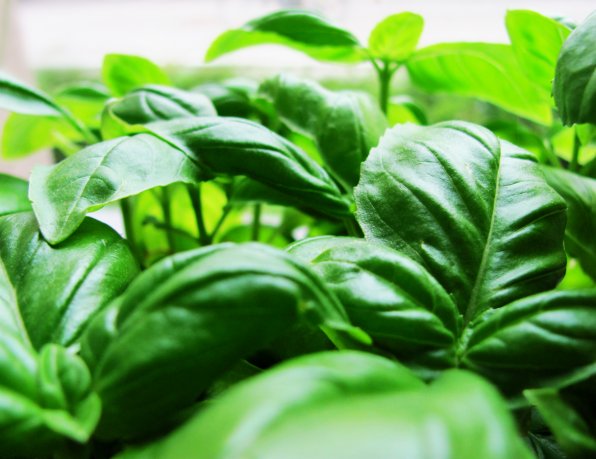If you've ever pinched the crown leaves off a basil plant growing in your garden, you know the pleasant aroma and the feel of those thick leaves on your fingertips. Now, the taste of that basil leaf in your salad or on a slab of mozzarella cheese with a slice of tomato – delicious! Herbs are tasty, fun and easy to grow. I'll share with you some of my favorites and different ways to enjoy them. But first, let me say that all these plants want lots of sun and rich soil. Also, you want your herbs planted close by, where you pass them often to say hello, providing easy access for picking as you prepare your gustatory feast.
Basil
Basil is a must-have annual herb. Of royal roots, the plant name is derived from the Greek word for king, basileus. It is said that, in Italy, basil was given to a loved one as a pledge of fidelity, and young men tucked a leaf behind an ear to go courting. You can sow basil seed directly in to the garden as soon as the soil is warm. With our short growing season, I prefer to start plants indoors. Basil does best in hot summer sun and could do well in a pot on your deck or sunny windowsill. Snipping new leaf buds off periodically promotes a strong and bushy plant, and you can add those snippets to your salad or your herbed vinegar for later use. Of course, basil makes a delicious pesto. Medicinally, basil steeped as a tea is a good tonic for melancholy and the leaves are reputed to be an aphrodisiac.
Rosemary
Rosemary is another aromatic herbal friend. I've never started it from seed, but purchase a small plant from a local organic grower. Enjoy rosemary yearround by potting it and taking it in for the winter. I leave mine by our back slider door, where it's nice and cool. When those leaves are brushed by the curtain or legs as we pass by, the aroma wafts up to remind us of how delicious rosemary is. In cooking, rosemary twigs can be tucked under the skin of chicken before roasting or chopped up in lamb or fish dishes.
Lemon balm
A fragrant perennial, lemon balm is a happy plant that could well take over your garden. You can contain it by potting a batch and bringing it into the house for the winter. Lemon balm, one of nature's best “nervines,” is calming and has antiviral and antiseptic properties as well. Medicinally it is best used by steeping fresh leaves in a tea. You can also harvest the leaves and dry them for later use. I use my salad spinner to wash any fresh herbs. One way to dry them is to place them in a paper bag and leave them in your car on a hot sunny day, right up under the windshield. They'll dry in a day or two. Other methods are hanging herbs in a cool, dry place or in a basket, out of direct sunlight.
Lovage
Lovage is a tall flavorful perennial that tastes more like celery than celery! It was brought to America by early English colonists. Celery was hard to establish in the cold Massachusetts climate, and lovage proved to be a good substitute. Gather the seeds just as they ripen, or let them fall for next year's new young plants. In the kitchen, hollow lovage stems can be stuffed with hummus or nut butter and served as an appetizer. The dried leaves are a tasty addition to winter soups and stews. Medicinally, it is thought to aid digestion.
Sage
Sage is a hardy perennial with rich culinary and medicinal value. Its Latin name, salvia, comes from the verb salvare, meaning “to save.” Old tradition called for planting rue next to sage, with the intent that the bitter herb would protect sage from toads. Sage seeds can be planted directly into your garden soil. The plant likes warm dry soil. In foods, add sage leaves finely chopped and in relatively small amounts. Its distinct flavor is strong and best appreciated when added toward the end of cooking. As a tea, sage is soothing for a sore throat, relieving inflammation of mucous membranes of the mouth and throat. It is effective as a mouthwash or gargle as well.
Bergamot
Bergamot (bee balm) is an aromatic, pretty perennial that is lovely in both an ornamental or kitchen garden. I fell in love with the goofy, Dr. Suess-style red flowers of bee balm when they attracted so many charming hummingbirds to my garden. Pinch the flower gently to capture its distinct aroma. The blooms are yummy tossed in your salad and all color as well. The leaves make a fine summer tea. Best to harvest the flowers and leaves in the high heat of summer. A member of the mint family, bergamot is prone to spreading. Early spring is the best time to pide and share the plant with friends and family. Anise hyssop, another member of the mint family, has a beautiful purple spike flower that also attracts hummers and bees. Its leaves have a distinct licorice flavor. I enjoy it most as a cool refreshing summer tea.
Remember to include a variety of mints and perhaps give them their own garden space away from others. Some of my favorites are spearmint, orange mint and chocolate mint. Snip a chocolate mint leaf and rest it on your tongue – it tastes like winter and summer, combined!
Sunny calendula, an annual, produces bright yellow blooms well into the fall. Blossoms, rich in beta carotene, add nourishment, flavor and color to soups, salads and casseroles. I enjoy solar infusing the bright buds in grape seed oil, which I later use in a batch of homemade skin cream. Harvest its curly seeds and start them indoors in the spring, or direct sow them into warm soil. A few will “volunteer” year-to-year if you're lucky!
Judi Abbe tends her herb garden at her home in Boscawen. To learn more about gardening with herbs, join the Capital Area Organic Gardeners on Aug 18 at 7 p.m. at the Grace Episcopal Church in East Concord. For more information,visit ccognh.wordpress.com.









